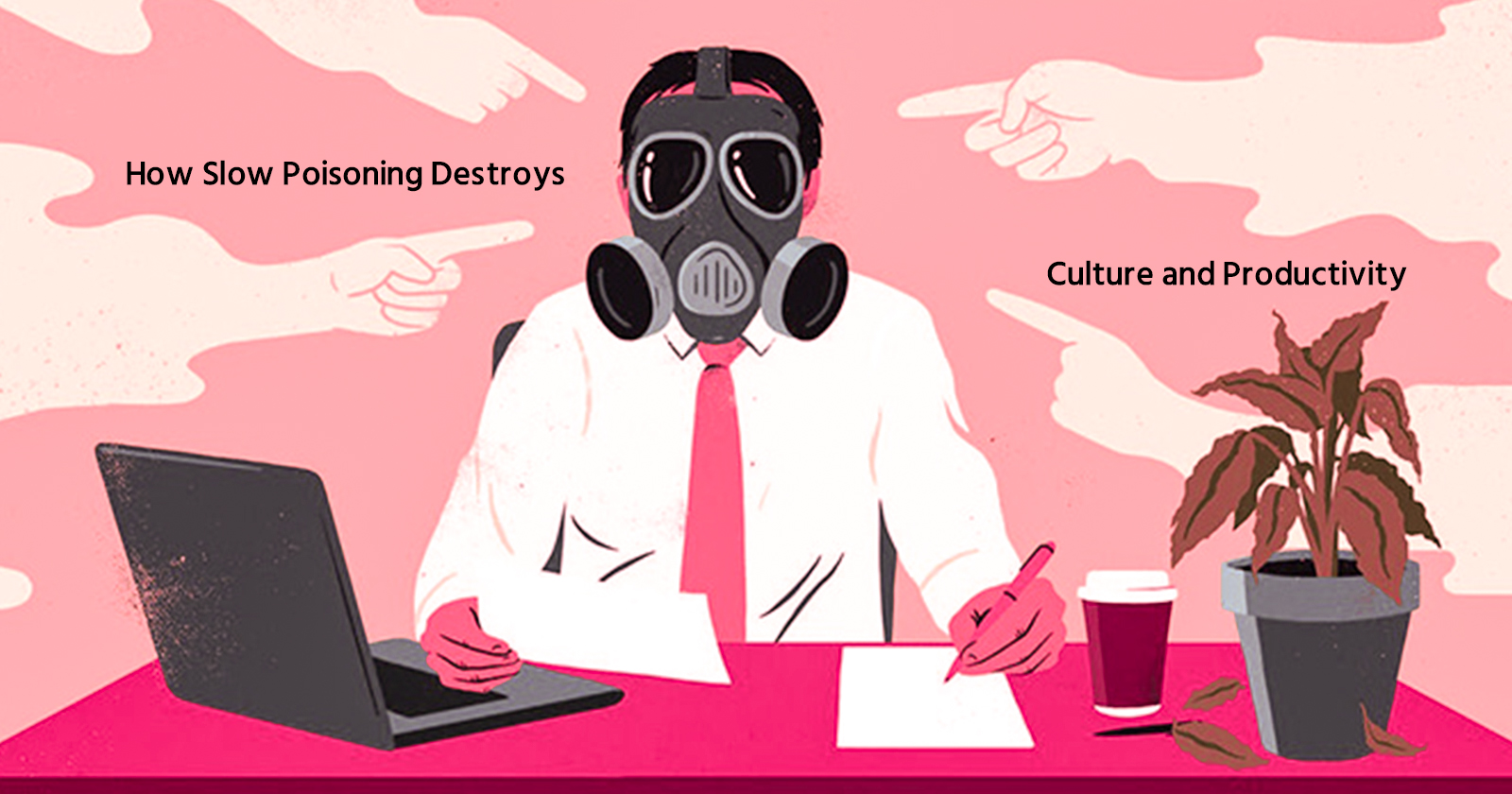How Slow Poisoning Destroys Workplace Culture and Productivity
 Romman Sabbir
Romman Sabbir
In today's fast-paced corporate world, many organizations experience a gradual decline in their work environment quality. This "slow poisoning" happens when employee morale, productivity, and well-being slowly erode due to toxic behaviors, poor leadership, or harmful policies.
Unlike sudden crises, this decline is hard to notice until it's too late.
Understanding the causes of slow poisoning can help companies spot and fix these issues before they become serious problems.
Key Factors Contributing to Slow Poisoning
Several subtle yet damaging factors can contribute to slow poisoning in the workplace. Below, we elaborate on some of the most common causes and their impact on both employees and the broader organization.
1. Poor Leadership
Leadership is the cornerstone of any organization’s success. However, when leaders are inconsistent, authoritarian, or disconnected from their teams, they foster an environment of uncertainty and distrust. Poor leadership can manifest in various ways, including unclear communication, lack of support, and ineffective decision-making. Employees often feel uninformed and uncertain about their roles and responsibilities. Over time, this leads to decreased morale, as employees lose confidence in both their leaders and the direction of the company.
Impact: When employees deal with poor leadership, they start to check out mentally, which means lower productivity and more people quitting. Decision-making slows down because team members are afraid to take action, worried they might get in trouble or be misunderstood.
2. Lack of Communication
Clear communication is essential for a functional work environment. When leadership or teams fail to communicate effectively, confusion and frustration arise. Employees may not fully understand their tasks, roles, or the company's goals, leading to a sense of isolation and disconnection. Miscommunication can occur at any level, from leadership down to individual teams, exacerbating the issue.
Impact: When there's a lack of communication, misunderstandings happen all the time, and a lot of time gets wasted as employees try to guess what's expected of them. This frustration wears them down, leading to low engagement and killing the team spirit.
3. Micromanagement
Micromanagement is one of the most effective ways to demotivate employees. When managers continuously oversee every minor task and provide little autonomy, employees feel they are not trusted to perform their work independently. This approach not only stifles creativity but also limits opportunities for employees to grow and develop their problem-solving skills.
Impact: Over time, micromanagement makes employees check out because they feel undervalued and powerless. It ramps up stress and kills job satisfaction, which eventually drags down productivity and creativity in the team.
4. Unrealistic Expectations
Setting ambitious goals can be motivating, but when expectations are consistently unattainable, it results in stress, frustration, and burnout. Unrealistic expectations often arise from poor planning, insufficient resources, or a misunderstanding of the work required. Employees may feel overwhelmed as they are continually asked to do more than is feasible, without the necessary support or tools.
Impact: When employees are set up to fail, their self-esteem and confidence take a nosedive. Always chasing impossible goals leads to constant stress, burnout, and a lack of interest. Over time, this means more sick days, poor mental health, and lower productivity.
5. Lack of Recognition
Everyone desires to feel appreciated for their contributions, and when employees do not receive recognition for their hard work, they become disheartened. Whether it is a simple acknowledgment of a job well done or more formal rewards and incentives, recognition serves as a powerful motivator. In a culture where achievements are ignored or downplayed, employees may feel that their efforts are in vain.
Impact: Over time, not getting recognized makes employees less motivated and more disengaged. They stop putting in extra effort because they know it won't be appreciated. This creates a work culture where people just do the bare minimum, leading to lower performance and morale.
6. Toxic Work Culture
A toxic work culture is characterized by negative behaviors such as gossip, favoritism, power struggles, or unethical practices. This type of environment fosters distrust, insecurity, and resentment among employees. When workers are more focused on office politics than on achieving common goals, the company's mission is adversely affected.
Impact: In a toxic culture, people might get hostile or just check out completely. Teamwork falls apart, collaboration takes a hit, and overall productivity goes down. Eventually, this creates a nasty environment that kills creativity, innovation, and makes it hard to keep good employees around.
7. Work Overload
Chronic overwork is one of the most prevalent issues in modern workplaces. When employees are consistently assigned excessive workloads without adequate breaks or balance, it results in physical and mental exhaustion. This situation often arises when companies are understaffed, or management fails to delegate tasks appropriately, leaving employees to bear an undue amount of responsibility.
Impact: Work overload leads to burnout, which is basically chronic stress that tanks productivity and engagement. Burnt-out employees might take more sick days, mess up more often, and even quit. Over time, this creates a vicious cycle of high turnover and an even more overworked team.
8. Inequality or Bias
This issue is particularly hazardous. Discrimination or favoritism based on gender, race, age, or other factors significantly contributes to a toxic work environment. When certain employees are treated unfairly or overlooked for opportunities due to biases, it fosters resentment and division within the team. Bias also prevents a company from benefiting from diverse perspectives and talents.
Impact: Inequality at work makes people feel unfairly treated, unmotivated, and disconnected. Those who feel left out might pull back, get less done, or start looking for new jobs. This hurts team spirit and teamwork, making it tough for the company to succeed.
Long-Term Consequences of Slow Poisoning
If ignored, the factors causing slow poisoning can severely harm an organization in the long run. Over time, low morale, burnout, and disengagement lead to:
High Employee Turnover: Unhappy employees will leave for better jobs, causing high recruitment and training costs.
Reduced Productivity: Disengaged employees are less productive, leading to lower efficiency and poorer work quality.
Damaged Reputation: A toxic workplace can hurt a company’s reputation, making it hard to attract and keep top talent.
Lack of Innovation: When employees feel unappreciated, overworked, or micromanaged, their creativity and problem-solving skills suffer. This leads to stagnation and a lack of innovation.
Preventing Slow Poisoning in the Workplace
To prevent slow poisoning, organizations must take proactive steps to create a healthy work environment. Here are some strategies for fostering a positive, supportive workplace:
Strong Leadership: Invest in leadership development to ensure managers lead with empathy, clarity, and support.
Open Communication: Encourage transparent and open communication at all levels, making sure employees feel heard and understood.
Autonomy: Trust employees to manage their own work and give them the freedom to make decisions within their roles.
Realistic Expectations: Set achievable goals and provide the resources and support employees need to succeed.
Recognition: Regularly acknowledge and celebrate employee achievements to foster a sense of belonging and motivation.
Positive Culture: Cultivate an inclusive, fair, and supportive workplace culture that values diversity and teamwork.
Balanced Workloads: Ensure employees have manageable workloads and enough time for rest and recovery.
Address Inequality: Implement policies and practices that promote fairness and address bias, ensuring equal opportunities for all employees.
Conclusion
Slow poisoning in the workplace is a gradual yet destructive force that can erode an organization from within. By understanding the key factors contributing to this phenomenon—poor leadership, lack of communication, micromanagement, unrealistic expectations, lack of recognition, toxic culture, work overload, and inequality—companies can take steps to prevent these issues before they take root.
Creating a healthy, positive work environment isn’t just good for employees—it’s essential for the long-term success and sustainability of any organization.
With dedication and proactive measures, we can build workplaces where everyone thrives and feels valued.
Subscribe to my newsletter
Read articles from Romman Sabbir directly inside your inbox. Subscribe to the newsletter, and don't miss out.
Written by

Romman Sabbir
Romman Sabbir
Senior Android Engineer from Bangladesh. Love to contribute in Open-Source. Indie Music Producer.